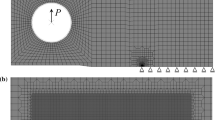Abstract
It is shown that closure mechanisms alone cannot fully explain increasing fatigue thresholds with decreasing test temperature for a sequence of Fe-Si binary alloys and an HSLA steel. Implications are that fatigue crack propagation near threshold is a thermally activated process. The effective threshold stress intensity, which was obtained by subtracting the closure portion from the fatigue threshold, was examined. This effective stress intensity was found to correlate very well to the thermal component of the flow stress. A detailed fractographic study of the fatigue surface was performed. Water vapor in the room air was found to promote the formation of oxide and intergranular crack growth. At lower temperature, a brittle-type cyclic cleavage fatigue surface was observed but the ductile process persisted even at 123 K. Arrest marks were found on all three modes of fatigue crack growth. The regular spacings between these lines and dislocation modeling suggested that fatigue crack growth was controlled by the subcell structure near threshold. A model based on the slip-off of dislocations was examined. From this, it is shown that the effective fatigue threshold may be related to the square root of (one plus the strain rate sensitivity).
Similar content being viewed by others
References
W. Yu and W.W. Gerberich:Scripta Met., 1983, vol. 17, pp. 105–10.
W. W. Gerberich, W. Yu, and K. Esaklul:Metall. Trans. A, 1984, vol. 15A, p. 875.
R.J. Bucci, B.N. Greene, and P.C. Paris: ASTM STP 536, 1973, pp. 206-28.
F. R. Stonesifer:Eng. Fract. Mech., 1978, vol. 10, pp. 305–14.
N.R. Moody and W.W. Gerberich:Mat. Sci. and Eng., 1979, vol. 41, pp. 271–80.
L. H. Burck and J. Weertman:Metall. Trans. A, 1976, vol. 7A, pp. 257–64.
E. Tschegg and S. Stanzl:Acta Metall., 1981, vol. 29, pp. 33–40.
J. P. Lucas and W. W. Gerberich:Mat. Sci. and Eng., 1981, vol. 51, pp. 203–12.
W. Eiber: ASTM STP 406, Am. Soc. for Test, and Mat’ls., 1971, pp. 230-42.
Y.T. Chen, D.G. Atteridge, and W.W. Gerberich:Acta Metall., 1981, vol. 29, pp. 1187–1201.
W. W. Gerberich, Y.T. Chen, D. G. Atteridge, and T. Johnson:ibid., 1981, vol. 29, pp. 1187–1201.
K. Sadananda and P. Shahinian:Int. J. of Fracture, 1977, vol. 13, pp. 585–94.
H. Abdel-Raouf, P.P. Benham, and A. Plumtree:Canadian Met. Quar., 1971, vol. 10, pp. 87–95.
J. Lankford:Fatigue of Eng. Mat. and Struct., 1982, vol. 5, pp. 233–48.
J. Fitzgerald: private communication quoted in Ref. 14.
W. W. Gerberich and K. Jatavallabhula:Acta Metall., 1983, vol. 31, pp. 241–55.
W. W. Gerberich and K. A. Peterson: inMicro and Macro Mechanics of Crack Growth, K. Sadananda, B. B. Rath, and D. J. Michel, eds., TMS-AIME, Warrendale, PA, 1982, pp. 1–17.
H. Mughrabi, K. Herz, and X. Stark:Int. J. Fracture, 1981, vol. 17, pp. 193–220.
D. L. Davidson:in Fatigue Mechanisms, J. J. Fong, ed., ASTM STP 675, Am. Soc. for Test, and Mat’ls., 1979, pp. 254-75.
D.L. Davidson and J. Lankford:Int. J. Fracture, 1981, vol. 17, pp. 257–75.
K. Herz, H. Mughrabi, and M. Wilkens: “Cyclic deformation of α-Fe single crystals in the saturation regime as a function of the strain rate,” Report MPI/77/P3, Max-Planck-Institut für Metallforschung, Institut für Physik, Stuttgart, 1977.
F. Ackermann: Ph.D. Thesis, University of Stuttgart, 1981.
S. Ikeda: inStrength of Metals and Alloys, P. Haasen, V. Gerold, and G. Kostory, eds., Pergamon Press, Oxford, 1980, pp. 1157–1166.
Author information
Authors and Affiliations
Additional information
Formerly Research Assistant with the Department of Chemical Engineering and Materials Science, University of Minnesota, Minneapolis, MN.
Formerly Research Assistant with the Department of Chemical Engineering and Materials Science, University of Minnesota, Minneapolis, MN.
Rights and permissions
About this article
Cite this article
Yu, W., Esaklul, K. & Gerberich, W.W. Fatigue threshold studies in Fe, Fe-Si, and HSLA steel: Part II. thermally activated behavior of the effective stress intensity at threshold. Metall Trans A 15, 889–900 (1984). https://doi.org/10.1007/BF02644563
Received:
Issue Date:
DOI: https://doi.org/10.1007/BF02644563




